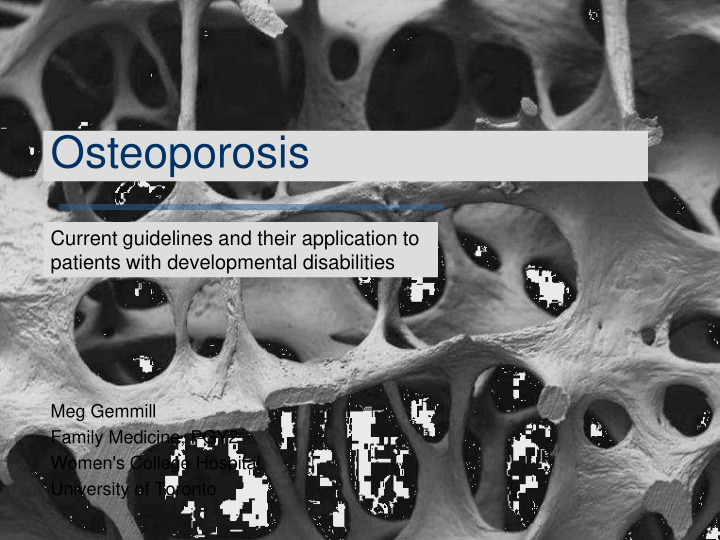



Osteoporosis Current guidelines and their application to patients with developmental disabilities Meg Gemmill Family Medicine, PGY2 Women's College Hospital University of Toronto
Objectives Review the definition and epidemiology of osteoporosis Highlight key points from the 2010 Osteoporosis Canada guidelines Review the diagnosis and screening for osteoporosis in patients with developmental disabilities
Osteoporosis: definition Bone demineralization decreased bone strength increased risk of fractures Bone density > 2.5 SD below the average for young, healthy adults of the same sex (T-score) Harrison’s Principles of Internal Medicine, 2008
Osteoporosis: epidemiology Canada As many as 2 million Canadians 1 in 4 women > 50 y.o. 1 in 8 men > 50 y.o. Canadian Population with Developmental Disabilities Prevalence varies 21% of community-dweling adults, 40-60 y.o. Osteoporosis Canada, 2010 ; Management Guidelines: Developmental Disability, 2005
Bone Mineral Density Measured by DEXA scan Spine, femoral neck and total hip High specificity but low sensitivity T-score Compares results to the average for young, healthy adults of the same sex Z-score Compares results to age-, race- and sex-matched population Harrison’s Principles of Internal Medicine, 2008; New osteoporosis guidelines for Canada, CMAJ 2010, 182(17): 1829 -1930
Osteoporosis Canada 2010 Guidelines Updated from 2002 For women and men > 50 y.o. Shift from treating low bone mineral density to preventing fragility fractures Indications for BMD Clinical tools Recommended diagnostic algorithm Clinical practice guidelines for the diagnosis and management of osteoporosis in Canada, CMAJ 2010.
Clinical practice guidelines for the diagnosis and management of osteoporosis in Canada, CMAJ 2010.
Clinical Tools WHO Fracture Risk Assessment Tool (FRAX) Canadian Association of Radiologists and Osteoporosis Canada (CAROC) Assessment Tool Clinical practice guidelines for the diagnosis and management of osteoporosis in Canada, CMAJ 2010.
Clinical practice guidelines for the diagnosis and management of osteoporosis in Canada, CMAJ 2010.
Clinical practice guidelines for the diagnosis and management of osteoporosis in Canada, CMAJ 2010.
Clinical practice guidelines for the diagnosis and management of osteoporosis in Canada, CMAJ 2010.
Clinical practice guidelines for the diagnosis and management of osteoporosis in Canada, CMAJ 2010.
Treatment Exercise and falls prevention Calcium - elemental (1200 mg daily from diet and supplement) Vitamin D (1000 IU daily) Bisphosphonates Clinical practice guidelines for the diagnosis and management of osteoporosis in Canada, CMAJ 2010.
In the DD Population Osteoporosis and osteoporotic fractures are more prevalent and occur earlier than the general population Osteoporosis is commonly unrecognized and therefore untreated Screening threshold should be lower If results are not used to make treatment decisions, they can still be used as a baseline Management Guidelines: Developmental Disabilities, 2005; Primary Care of Adults with Developmental Disabilities: Canadian Consensus Guidelines (2011)
PCDD Guidelines: Risk Factors Severity of DD Low body weight Impaired mobility and impaired weight bearing Impaired nutritional intake Propensity to fall Hypogonadism Hyperprolactinemia Hypothyroidism Amenorrhea Specific genetic syndromes Long-term use of specific drugs Primary Care of Adults with Developmental Disabilities: Canadian Consensus Guidelines (2011)
PCDD Guidelines Monitor weight and height regularly and assess risk status using BMI Periodically assess risk for developing osteoporosis in all age groups of male and female patients with DD. Those at high risk warrant regular screening starting in early adulthood. Recommend early and adequate intake or supplementation of calcium and vitamin D unless contraindicated (e.g. in Williams syndrome). Primary Care of Adults with Developmental Disabilities: Canadian Consensus Guidelines (2011 )
Management of Osteoporosis in the DD Population Exclude or treat underlying causes BMD Pharmacotherapy: calcium supplement, vitamin D supplement, bisphosphonate Remove risk factors for fractures Treat pain Restore mobility Management Guidelines: Developmental Disabilities, 2005
Adverse Effects of Bisphosphonates Osteonecrosis of the jaw Atypical fractures of the femur Esophageal cancer Atrial fibrillation If 10-year fracture risk is high, benefits of bisphosphonate use outweigh risk of therapy. Clinical practice guidelines for the diagnosis and management of osteoporosis in Canada, CMAJ 2010.
Falls Prevention Optimize vision Improve lighting, eliminate glare Review medications sedatives, drugs altering gait or causing hypotension OT referral for in-home equipment rails, walking aids PT referral for gait and balance training Management Guidelines: Developmental Disabilities, 2005
Conclusions Shift in screening from treating low BMD to reducing risk of fractures BMD indications FRAX, CAROC assessment tools Guidelines need interpretation for DD population Assess other risk factors if BMD unhelpful medications, frequent falls, underlying conditions Serial BMD to monitor for rapid bone loss Balance the benefits and risks of bisphosphonates before starting therapy
References Fauci, Anthony S. et al. Harrison’s Principles of Internal Medicine . USA: McGraw-Hill 2008. 17th ed. Kanis, J.A. New Osteoporosis guidelines for Canada . Canadian Medical Association Journal 2010. 182(17): 1829-1830. Lennox, N. et al. Management guidelines: Developmental Disabilities. State of Victoria: Therapeutic Guidelines 2005. 2nd ed. What is osteoporosis? www.osteoporosis.ca, Osteoporosis Canada, 19 December 2010. Papaioannou, A. et al. 2010 clinical practice guidelines for the diagnosis and management of osteoporosis in Canada: summary. Canadian Medical Association Journal 2010. 182(17): 1864-1873. Rubin, I. L. and Crocker, A.C. Medical Care for Children and Adults with Developmental Disabilities. Maryland: Paul H. Brookes Publishing 2006. 2nd ed. Sullivan, W.F. et al. Primary care of adults with developmental disabilities: Canadian consensus guidelines. Canadian Famly Physician 2011. 57(5):541-553.
Questions?
Recommend
More recommend